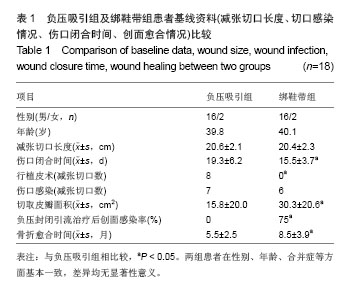| [1]Mubarak SJ, Pedowitz RA, Hargens AR. Compartment syndromes. Curr Orthop. 1989;3:36-40.
[2]Johnson SB, Weaver FA, Yelling AE. Clinical results of decompressive dermotomy–fasciotomy. Am J Surg. 1992; 164:286-290.
[3]Mabee JR. Compartment syndrome: a complication of acute extremity trauma. J Emerg Med. 1994;12:651-656.
[4]Velmahos GC, Theodorou D, Demetriades D, et al. Complications and nonclosure rates of fasciotomy for trauma and related risk factors. World J Surg. 1997;21: 247-252.
[5]Hussmann J, Kucan JO, Zamboni WA. Elevated compartmental pressures after closure of a forearm burn wound with a skin stretching device. Burns. 1997;23: 154-156.
[6]Saffle JR, Zeluff GR, Warden GD. Intramuscular pressure in the burned arm: measurement and response to escharotomy. Am J Surg. 1980;140:825-830.
[7]Mubarak SJ, Hargens AR. Acute compartment syndromes. Surg Clin North Am. 1983;63:539-565.
[8]Armstrong DG, Lavery LA. Negative pressure wound therapy after partial diabetic foot amputation :a multicentre randomized controlled trials. Lancet. 2005;366(9498): 1704-1710.
[9]John KKT, Richard MC, Michael SM.美国负压创面治疗技术[M].周长青,译.北京:科学技术文献出版社,2005.
[10]蒋琪霞,刘云,徐薇,等.负压伤口治疗关键技术的研究进展[J].医学研究生学报,2007,20(6):656-659.
[11]蒋琪霞,刘云,徐薇,等.负压伤口治疗技术在临床应用中的新进展[J].解放军护理杂志,2007,24(8):29-31.
[12]Venturi ML, Attinger CE, Mesbahi AN, et al. Mechanisms and clinical applications of the vacuum-assisted closure(VAC) device: a review. Am J Clin Dermatol. 2005;6(3):185-194.
[13]Wanner MB, Schwarz F. Vacuum-assisted wound closure for cheaper and more comfortable healing of pressure sores: a prospective study. Scand J Plast Reconctr Surg Hand Surg. 2003;37(1):28-33.
[14]Cohn BT, Shall J, Berkowitz M. Forearm fasciotomy for acute compartment syndrome: a new technique of delayed primary closure. Orthopedics 1986;9:1243-1246.
[15]苏福锦,王卡琳,黄国福,等.负压封闭引流技术在急诊四肢重度创伤软组织缺损修复中的应用[J].广西医科大学学报,2009,26(3): 437-438.
[16]王顺富,王学文,蔡成,等.骨科负压封闭引流技术的临床应用[J].中华医院感染学杂志,2007,17(4):420-422.
[17]Zannis J, Angobaldo J, Marks M, et al. Comparison of fasciotomy wound closures using traditional dressing changes and the vacuum-assisted closure device. Ann Plast Surg. 2009;62:407-409.
[18]Shao Y, Zou H, Chen S, et al. Meta-analysis of reamed versus unreamed intramedullary nailing for open tibial fractures. J Orthop Surg Res. 2014;9:74.
[19]Wang WH, Xu D, Han YM, et al. Osteofascial compartment syndrome caused by hand crush injury in a newborn infant. Zhongguo Dang Dai Er Ke Za Zhi. 2014;16(7):767-768.
[20]Newman PA, Deo S. Non-traumatic compartment syndrome secondary to deep vein thrombosis and anticoagulation. BMJ Case Rep. 2014.
[21]Flautt W, Miller J. Post-surgical rehabilitation following fasciotomies for bilateral chronic exertional compartment syndrome in a special forces soldier: a case report. Int J Sports Phys Ther. 2013;8(5):701-715.
[22]Lin J, Wang QG, Huang JH, et al. Assisting plate with reamed intramedullary nailing for segmental fractures of proximal-middle tibia. Beijing Da Xue Xue Bao. 2013;45(5): 717-722.
[23]Kenny RM, Beiser CW, Patel A. Supraspinatus and infraspinatus compartment syndrome following scapular fracture. Int J Shoulder Surg. 2013;7(1):28-31.
[24]Zhang TC. Types of pediatric trauma in earthquake and key points of treatment. Zhongguo Dang Dai Er Ke Za Zhi. 2013; 15(6):416-418.
[25]Zhang H, Zeng JW, Wang GL, et al. Infectious complications in patients with crush syndrome following the Wenchuan earthquake. Chin J Traumatol. 2013;16(1):10-15.
[26]Huang B, Zhao J, Ma Y, et al. Repair and reconstruction of infective femoral false aneurysm caused by drug injection. Zhongguo Xiu Fu Chong Jian Wai Ke Za Zhi. 2011;25(8): 1001-1003.
[27]Jamil W, Khan I, Robinson P, et al. Acute compartment syndrome of the forearm secondary to infection within the space of Parona. Orthopedics. 2011;34(9):e584-e587.
[28]Wang J, Wang C. Osteofascial compartment syndrome. J Craniofac Surg. 2011;22(3):1100-1102.
[29]Leversedge FJ, Moore TJ, Peterson BC, et al. Compartment syndrome of the upper extremity. J Hand Surg Am. 2011; 36(3):544-560.
[30]Yao Q, Chen Y, Zhang G, et al. Diagnosis and surgical treatment of tarsometatarsal joint complex injuries. Zhongguo Xiu Fu Chong Jian Wai Ke Za Zhi. 2010;24(12):1437-1439.
[31]Zhu Y, Xu Y, Li J, et al. Surgical treatment of Morel-Lavallée lesion with perineal lacerations. Zhongguo Xiu Fu Chong Jian Wai Ke Za Zhi. 2010;24(6):726-729.
[32]Peng J, Hu M, Zhou J, et al. Clinical observation of hidden tension suture with absorbable thread. Zhongguo Xiu Fu Chong Jian Wai Ke Za Zhi. 2010;24(3):319-321.
[33]Chen W, Li X, Zheng Z, et al. Retrospective analysis of complications of supracondylar fracture of humerus in children. Zhongguo Xiu Fu Chong Jian Wai Ke Za Zhi. 2010; 24(3):315-318.
[34]Yang SW, Zhou YJ, Shi DM, et al. Safety and feasibility of transradial coronary angiography at the outpatient clinic. Zhonghua Xin Xue Guan Bing Za Zhi. 2009;37(11): 1022-1025.
[35]Liu L, Tang X, Pei FX, et al. Treatment for 332 cases of lower leg fracture in “5.12” Wenchuan earthquake. Chin J Traumatol. 2010;13(1):10-14.
[36]Zhu XJ, Zhao Y, Wang GX, et al. Early diagnosis and therapy of osteofascial compartment syndrome of the foot. Zhongguo Gu Shang. 2009;22(11):866-867.
[37]Chen Z, Dai Z, Yang L, et al. Treatment of Schatzker V/VI tibial plateau fracture involved posteromedial condyle through combined approach. Zhongguo Xiu Fu Chong Jian Wai Ke Za Zhi. 2009;23(11):1319-1322. |

.jpg)
.jpg)